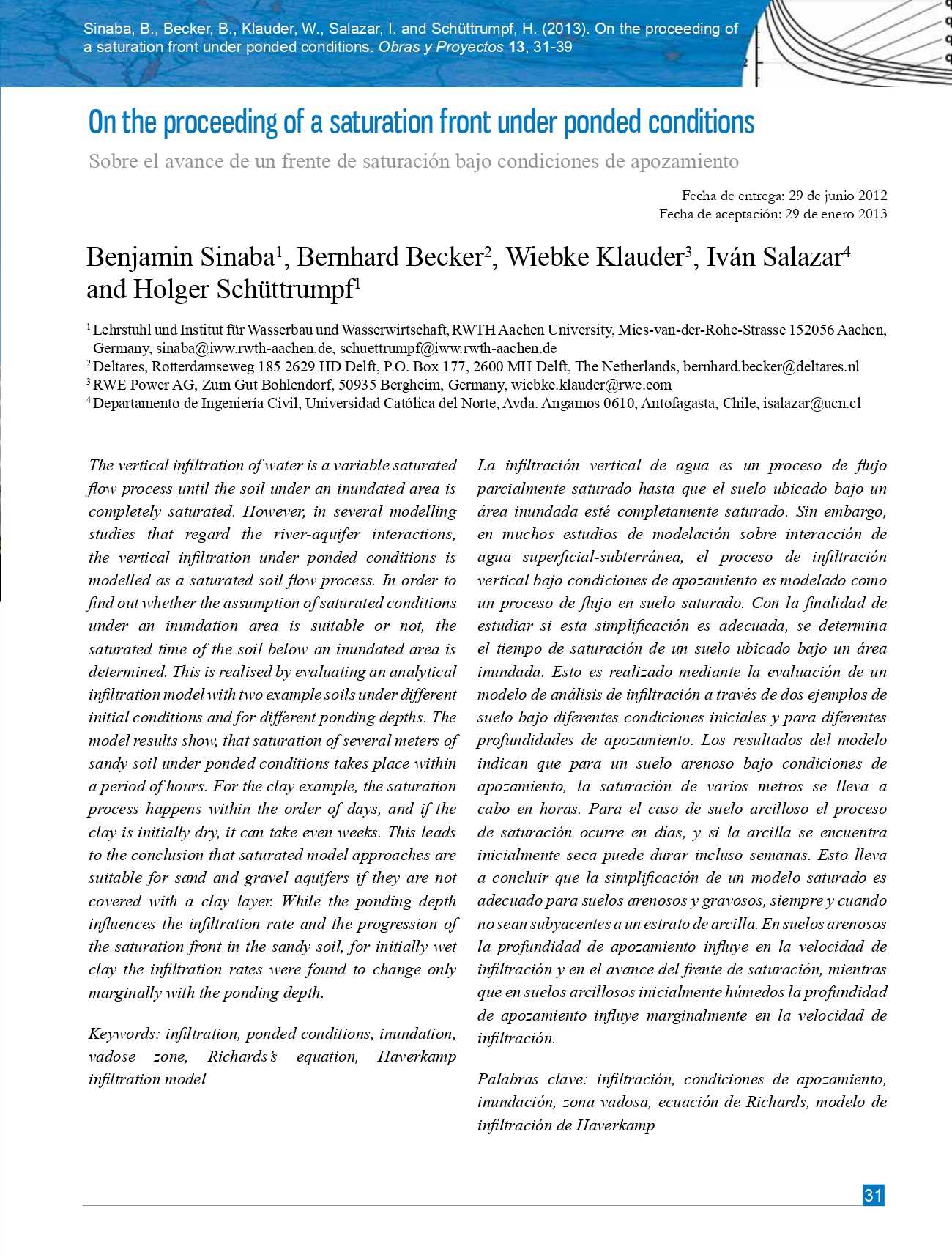Sobre el avance de un frente de saturación bajo condiciones de apozamiento
DOI:
https://doi.org/10.4067/S0718-28132013000100003Palabras clave:
infiltración, condiciones de apozamiento, inundación, zona vadosa, ecuación de Richards, modelo de infiltración de HaverkampResumen
La infiltración vertical de agua es un proceso de flujo parcialmente saturado hasta que el suelo ubicado bajo un área inundada esté completamente saturado. Sin embargo, en muchos estudios de modelación sobre interacción de agua superficial-subterránea, el proceso de infiltración vertical bajo condiciones de apozamiento es modelado como un proceso de flujo en suelo saturado. Con la finalidad de estudiar si esta simplificación es adecuada, se determina el tiempo de saturación de un suelo ubicado bajo un área inundada. Esto es realizado mediante la evaluación de un modelo de análisis de infiltración a través de dos ejemplos de suelo bajo diferentes condiciones iniciales y para diferentes profundidades de apozamiento. Los resultados del modelo indican que para un suelo arenoso bajo condiciones de apozamiento, la saturación de varios metros se lleva a cabo en horas. Para el caso de suelo arcilloso el proceso de saturación ocurre en días, y si la arcilla se encuentra inicialmente seca puede durar incluso semanas. Esto lleva a concluir que la simplificación de un modelo saturado es adecuado para suelos arenosos y gravosos, siempre y cuando no sean subyacentes a un estrato de arcilla. En suelos arenosos la profundidad de apozamiento influye en la velocidad de infiltración y en el avance del frente de saturación, mientras que en suelos arcillosos inicialmente húmedos la profundidad de apozamiento influye marginalmente en la velocidad de infiltración.
Referencias
Barry, D.A., Parlange, J.Y., Haverkamp, R. and Ross, P.J. (1995). Infiltration under ponded conditions: 4. An explicit predictive infiltration formula. Soil Science 160(1): 8-7.
Bauer, P., Gumbricht, T. and Kinzelbach, W. (2006). A regional coupled surface water/groundwater model of the Okavango Delta, Botswana. Water Resources Research 42, No. W04403. https://doi.org/10.1029/2005WR004234
Becker, B.P.J. (2010). Zur gekoppelten numerischen Modellierung von unterirdischem Hochwasser. Dissertation RWTH Aachen University
Becker, B.P.J., Forberig, S., Flogel, R., Schüttrumpf, H. and Kongeter, J. (2012). On the determination of groundwater levels for hazard maps of groundwater head rise induced by high water. Wasser Wirtschaft 12, 10-16
Beven, K. and Germann, P. (1982). Macropore and water flow in soils. Water Resources Research 18 (5): 1311-1325. https://doi.org/10.1029/WR018i005p01311
Chong, S.K. and Green, R.E. (1983). Sorptivity measurement and its application. In: Proceedings of the National Conference on Advances in Infiltration, American Society of Agricultural Engineers, 12-13 Dec. 1983, Chicago, Illinois, 82-91.
Freeze, R. A. (1972). Role of Subsurface Flow in Generating Surface Runoff. 1. Base Flow Contributions to Channel Flow. Water Resources Research 8, No. 3, 609-623. https://doi.org/10.1029/WR008i003p00609
Freeze, R.A. and Cherry, J.A. (1979). Groundwater. Prentice Hall, Englewood Cliffs, New Jersey.
Gillham, R.W. (1984). The capillary fringe and its effect on water table response. Journal of Hydrology 67, 307-324. https://doi.org/10.1016/0022-1694(84)90248-8
Green, W.H. and Ampt, G.A. (1911). Studies on Soil Physics: 1. Flow of Air and Water through Soils. The Journal of Agricultural Science 4, 1-4. https://doi.org/10.1017/S0021859600001441
Haverkamp, R., Parlange, J.Y., Starr, J.L., Schmitz, G. and Fuentes, C. (1990). Infiltration under ponded conditions: 3. A predictive equation based on physical parameters. Soil Science 149, No. 5, 292-300.
Homann, C. (2006). Automatische Optimierung von Grundwasserhaltungen in von Hochwasser beeinflussten Aquiferen. Dissertation RWTH Aachen University.
Huber, G., Hiller, G. and Braune, A. (2003). Konzepte des Hochwasserschutzes für die Bauten des Freistaates Sachsen im Historischen Stadtkern von Dresden. In: Umweltamt Landeshauptstadt Dresden and Dresdner Grundwasserforschungszentrum e.V. (eds.), Hochwassernachsorge Grundwasser Dresden, Wissenschaftliche Tagung zum BMBF-Forschungsprojekt/8.Oktober 2003/ Dresden, Rathaus/Tagungsband. Dresden Druckerei und Verlag Christoph Hille, 57-62.
Koch, A., Meon, G. and Leibundgut, C. (2007). Die gekoppelte Simulation der 2D-Oberflachenwasser- und 3D-Grundwasserstr0mung im Rahmen eines Expertensystems zur Modellierung der hydrodynamischen Wechselwirkungen einer Flusslandschaft. In: Meon, G., Sauter, Führbôter and Wolf (eds.): Niedersachsisches Grundwasserkolloquium 21.-22. Februar 2007 in Braunschweig. Grundwasser, Hochwasser und Salzwasser/Konzepte zur Risikominimierung. Stuttgart: E. Schweizerbart'sche Verlagsbuchhandlung (Nägele u. Obermiller), Zentralblatt für Geologie und Paläontologie/Teil I Allgemeine, Angewandte, Regionale und Historische Geologie Vol. 2007, No. 1/2, 99-114.
Kolymbas, D. (1998). Geotechnik: Bodenmechanik und Grundbau. Springer, Berlin.
Kreibich, H. and Thieken, A.H. (2008). Assessment of damage caused by high groundwater inundation. Water Resources Research 44, No. 9. http://doi.org/10.1029/2007WR006621.
Monninkhoff, B. and Kernbach, K. (2006). Coupled surface water - groundwater modeling for planning of flood retention in the Lower Havel area. In: Proceedings of the: International FEFLOW User Conference, September 10-15, 2006 Berlin, Germany, 115-124.
Peetz, J.-V. and Steckel, B. (2007). 3-code coupling in flood simulation. In: MpCCI 8th user forum proceedings, february 13 and 14, 2007, 108-116. http://www.mpcci.de/fileadmin/mpcci/Userforum/MpCCI_8th_UserForum.pdf
Philip, J.R. (1957). Theory of infiltration: 1. The infiltration equation and its solution. Soil Science 83(5), 345-358.
Philip, J.R. (1969). Theory of infiltration. Advances in Hydroscience 5, Academic Press, 215-296.
Rawls, J.W. and Brakensiek, D.L. (1983). A procedure to predict Green and Ampt infiltration parameters. In: Proceedings of the National Conference on Advances in Infiltration, American Society of Agricultural Engineers: 12.-13. Dec. 1983, Chicago, Illinois, 102-112.
Salazar, I. (2011). Beitrag zur Verringerung der Schadstoffkonzentration in heterogenen porosen Medien. Dissertation RWTH Aachen University.
Schaap, G. M. (2009). Rosetta: A computer program for estimating soil hydraulic parameters with hierarchical pedotransfer functions. url: http://ag.arizona.edu/research/rosetta/download/rosetta.pdf, checked 2009-12-10.
Schaap, M.G. and van Genuchten, M.T. (2006). A modified Mualem-van Genuchten formulation for improved description of the hydraulic conductivity near saturation. Vadose Zone Journal 5, No. 1, 27-34. https://doi.org/10.2136/vzj2005.0005
Schmitz, G., Haverkamp, R., Parlange, J.Y. and Liedl, R. (1989). Infiltration bei eingestauter Bodenoberflaeche. 1. Analytische Lôsung der Infiltrationsgleichung und praktische Berechnung der Versickerung. Zeitschriftfür Kulturtechnik und Landentwicklung 30, No. 2, 121-131.
Sinaba, B. (2007). Zur Infiltration bei eingestauter Bodenoberflache. Diplomarbeit RWTH Aachen University SLUG Sächsisches Landesamt für Umwelt und Geologie (2003). Einfluss des August Hochwassers 2002 auf das Grundwasser. Materialien zur Wasserwirtschaft.
Sommer, T. and Ullrich, K. (2004). Das unsichtbare Hochwasser - Auswirkungen des August-Hochwassers 2002 auf das Grundwasser im Stadtgebiet von Dresden. In: 34. IWASA Internationales Wasserbau-Symposium Aachen 2004 : Hochwasserschutz - eindeichen oder ausweichen. Mitteilungen des Inst. f. Wasserbau und Wasserwirtschaft, RWTH Aachen. Aachen: Shaker, 203-224.
Sommer, T. and Eulitz, K. (2007). Auswirkungen des Hochwassers auf das Grundwasser/Phänomene und Modellansätze. In: Meon, Sauter, Führbôter and Wolf (eds.): Niedersachsisches Grundwasserkolloquium 21.-22. Februar 2007 in Braunschweig: Grundwasser, Hochwasser und Salzwasser/Konzepte zur Risikominimierung. Stuttgart: E. Schweizerbart'sche Verlagsbuchhandlung (Nägele u. Obermiller), Zentralblatt für Geologie und Paläontologie/Teil I Allgemeine, Angewandte, Regionale und Historische Geologie Vol. 2007, No. 1/2, 7-15.
van Linn, A. (2006). Automatische Optimierung zur Bewertung USDA United States Department of Agriculture (2009). USDA Risikoanalyse einer Hochwasserschutzma fi nahme. Dissertation RWTH Aachen University. Textural Classification Chart. url: http://www.gintsoftware.com/Jdownloads/reports/usda_textural_class.pdf, checked 2009-12-10.
van Genuchten, R. (1978). Calculating the unsaturated hydraulic conductivity with a new closed-form analytical model. Water Resources Program: Department of Civil Engineering, Princeton University.

Descargas
Publicado
Número
Sección
Licencia
Derechos de autor 2013 Universidad Católica de la Santísima Concepción

Esta obra está bajo una licencia internacional Creative Commons Atribución-NoComercial 4.0.







